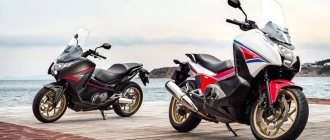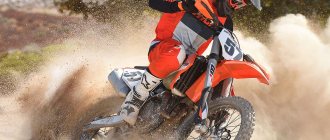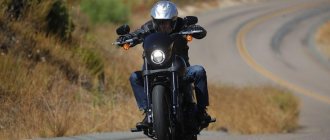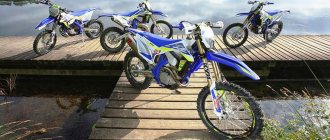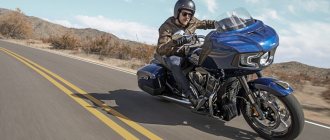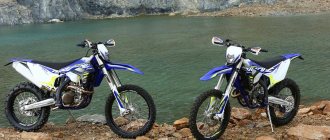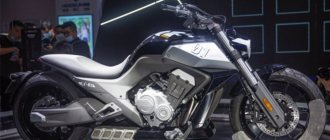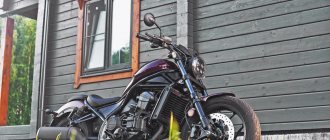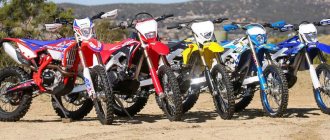2021 KTM Enduro Motorcycles
KTM recently held a global press event to unveil the 2021 EXC Enduro series of motorcycles. The event took place in a picturesque area in Europe, where mountain serpentines coexist with excellent parks, designed by nature itself for testing enduro motorcycles.
Our test rider has extensive experience in off-road competitions of various styles: starting with trials, he then moved to motocross, after which he came to enduro a couple of decades ago, and remained there, competing in enduro disciplines at the national and international level.
As luck would have it, he now owns a Beta 300 two-stroke and is relatively new to KTM's TPI-equipped two-strokes (TPI - KTM's patented technology for injecting mixture into the cylinder purge port of a two-stroke engine), making him the perfect tester for an unbiased review of the seven models in the series EXC 2020. The following text is from his words and in the first person.
Enduro motorcycle KTM 500 EXC-F
Enduro motorcycle KTM 500 EXC-F 2020
Jumping into a big 500 first thing in the morning may seem a bit presumptuous, but for me it's a way to get to know the track without having to worry too much about riding technique. Having warmed up in a 30-minute ride, I was ready for a detailed acquaintance with other models.
The first impression of the motorcycle seemed very pleasant. I immediately felt the quality of the non-slip seat upholstery and the softness of its foam filling, felt how well thought out the body kit was and what a great feeling of the motorcycle it gives in the rack, appreciated the work of the box, and generally formed an impression of the new models.
KTM 500 EXC-F 2020
This impression stayed with me all day, even when I gave up the 500 and drove the track again and again in each of the other 7 models. And although the motorcycles in the series are quite different, from the 150 TPI to the big 500, they are all similar in many ways and form a series not only by name, but also by the sensations of riding them. By the way, I still haven’t gotten used to their height of the footpegs and the length of the gearbox foot - if I bought one of them, the first thing I would do is change it.
The KTM 500 EXC-F has a deceptively mean look, but I didn't find it all that scary. Just a good fun bike that pulls and pulls until it hits the speed limit. And you don't have to drive at maximum speed to have fun - you can just stick it in third gear and ride it all day, letting it purr quietly at the bottom and burst out when you open the gas.
Motor electronics are the “brains” of the engine
The engine electronics, located under the seat, are an extremely complex system that determines spark timing and fuel quantity based on information it receives from the gauge, throttle position and oil and coolant temperatures. Thus, the driver does not require adjustment, only the old one remains. cold start button . Depending on the engine load, the electronics constantly determine the mixture ratio, which in practice means that oil consumption is reduced by half and fuel consumption by even 30 percent. During the day, when we usually stopped for photos and lunch, the KTM EXC 300 and 250 TPI consumed less than 9 liters of gasoline.
Enduro motorcycle KTM 300 EXC TPI
KTM 300 EXC TPI 2020
The first thing I want to note about the best-selling enduro model, the KTM 300 EXC TPI, is that I have virtually no knowledge of fuel-injected motorcycles. My personal 300 is a carb, and I've been racing carbs for almost my entire career, so I was curious as hell.
The first thing I noticed was how fast the gas works. In every sense: firstly, the throttle handle moves very easily, and secondly, how well the engine responds to the handle.
On my carburetor motorcycle, the gas works with a delay: the throttle is opened by a cable, the carburetor reacts to the changed patency, the petal valves open, and all this takes time. TPI does not require all this and works instantly.
KTM 300 EXC TPI 2020
It took some getting used to, but once I got used to it, I realized it was great. That is, you see a bump or a hole and want to lift the wheel over it - and on my carb motorcycle this requires some effort, but the 300 with TPI responds to the handle more clearly and willingly lifts the wheel over obstacles. At first I overdid the throttle a few times, but then, as I said, I got used to it and really enjoyed the suppleness.
KTM says the 2021 models have improved fuel delivery, traction smoothness and throttle precision thanks to an additional air pressure sensor, as well as a new throttle body that, in simple terms, is located as close to the engine as possible and operates more accurately.
I’ll also note that their new seats are something! The most non-slip seats I've ever sat on. Another nice feature is the new tail, which fits comfortably between your legs when going down steep slopes.
There is also a disadvantage to the tail: when I put my right hand under the rear fender, I did not find any handles there for dragging the rear of the motorcycle. Although it was before.
I had a nice ride on the KTM 300 EXC TPI, trying different surfaces and different things: fast stuff, extreme stuff and forest riding. And the suspension on the 300, it seemed to me, was weaker than on the 500, although quite decent.
The more I rode it, the more I thought about the future of off-road motorcycles. If the injector gives such a response, why do we need carbs?
ALL ABOUT KTM 300 2-START
You could probably call the KTM 300 Volksmotard; folk motorcycle. No matter what the pros are riding or what the champions are racing, the KTM is 300 was inspired, designed and demanded by everyday riders. American racers. Its list of professional championships is surprisingly short, but the KTM 300 is the most sought-after and respected dirt bike among average American regular guys, a position it has held for over 20 years.
1994 thousand T 300EXC
BOOK ENTRIES KTM has a long, long list of off-road champions. They all drove a 300 at some point, but were more closely associated with some other model. Kevin Hines was born before the modern 300, and only occasionally rode the 273 and 350 of his day. Jeff Russell and Mike Lafferty liked the 300, but raced the 250 more often en route to their national enduro titles. Scott Plesenger won the 250 in his GNCC titles, and while Shane Watts rode the 300 en route to the title in 2000, he also rode every other bike in the KTM lineup, just to say what he did. Juha Salminen, David Knight, Kurt Caselli, Russ Pearson and most of the other famous KTM athletes rode something else. In EnduroCross, Teddy Blazusiak has only recently warmed up to the 300, although his first major win came in the borrowed 300 at Erzberg. Despite all this, the 300 was at the top of the KTM sales charts for most of its 21-year run. This bike owes its success to real racers, not sales campaigns or factory races.
IN THE OLD DAYS Today, KTM is a name known almost like a family, with dozens of championships and a solid market share. But back in the 1980s, it was a little-known Austrian firm struggling to gain attention on the world stage. In the US one could only hope to regain the recognition that had been achieved under the Penton name 10 years earlier. But times were difficult, and the company was on the brink of financial disaster. His main calling card was the niche bike. KTM will explore strange offsets and non-standard applications. There were forest bikes, desert bikes, motocross bikes, and cross-platform bikes for a little bit of everything. The very first KTM 300 grew out of this philosophy. This was in 1986, when ISDE rules stated that a bike could run in the Open class if it was larger than a 250. By then, 250s were spinning faster than two 500cc strokes. See, that's why KTM decided to make the 250 for the Open class. The bore and stroke of the KTM 250 at the time was 67.5 by 69 mm, and engineers punched the cylinder all the way down. Three and a half millimeters later came the KTM 300, only it actually measured 273cc. At the same time, engineers tried the opposite approach, taking 500 and dropping it to 350.
As it turned out, the 350 was a better car, and it won on the public opinion playing field. The 300 was discontinued in 1987, but the 350 lived on. But the big engine was on its last legs, and everyone knew it. It still had a left-handed kickstarter and a right-handed output shaft. The 350 simply proved that the concept would work; that the maximum displacement of a two-stroke engine can be somewhere between 250 and 500 cc.
Mike Lafferty on the March 2004 DB cover on our '04 300 test bike.
SINGLE BIKE CLASS The big 250 machine concept inspired KTM engineers to try the idea again in 1990. Only this time they put a little more effort into the project. Both the bore and stroke were changed and the current 300 was born. This time it was 297 cc with a 72 x 73 mm bore and stroke. In addition, the port layout has changed, as well as the ignition timing and carburetion. The bike was eventually offered in several forms: EXC (forest), DMX (desert), SX (motocross) and TMX (EPA legal). 1992 was a strange year for KTM. The products have improved significantly. Sales were better than ever. But out of nowhere, the company suddenly declared bankruptcy. Everything stopped for a short time while the nasties on the financial instruments worked their dark magic and reorganized the entire corporation. When the smoke cleared, KTM reappeared, seemingly stronger than ever. For several years, the 300 remained in the shadow of the more successful 250EXC, which won shootout after shootout in the pages of Dirt Bike. 300 have not yet realized their true potential. The main cause was fire. When Motoplat went bankrupt, KTM had to look for a new ignition manufacturer. SEM got the job. It wasn't a bad unit - it worked well at 250. But 300 gained a reputation for being invincible. He was rich and thin at the same time. It wasn't until 1997 that KTM switched to Kokusan ignitions and almost all of these problems disappeared.
KTM 2008XC-W 300
Over the intervening period, KTM has expanded its niche philosophy by building the 360 on the same platform. This bike was offered in 1996 and 1997 but was not a hit. It was bumped up to 380 in 1998 and the bike was more popular, especially in the west and on motocross tracks. 1998 was a big year for a different reason. The entire line was completely redesigned to incorporate what would become KTM's signature design; PDS suspension without connection. The motocross world was never well received, but off-roaders loved it and the 300 began to gain traction. The following year brought a hydraulic clutch, and the 300 was unofficially chosen as America's dirt bike. KTM realized that the 300 was becoming The Bike and began investing more time and resources into engine development. The 2000 version came with a new cylinder, which was significantly improved. In 2004 the engine was redesigned again with a different bore and stroke; Oddly enough, the 250 and 300 share the same stroke again, but this time it worked better for both bikes. From here on out, the KTM 250 would absolutely dominate the dyno in two-stroke comparisons, with the 300 simply being a smoother, cooler version of the same thing. In '08, electric start came along and revolutionized the two-stroke world. It also received a small cylinder and a new processor.
2010 Husaberg TE300
The Husaberg chapter of the KTM 300 story began in 2010. KTM management wasn't quite sure what to do with Husaberg, which had been acquired 15 years earlier to kick-start its four-stroke program. For some time, a completely different line of motorcycles was offered under the Husaberg brand, but this turned out to be economically impractical. In the end, the Husaberg four-stroke engine became 90 percent KTM. In 2010, the 300 XCW became the first two-stroke to carry the Husaberg name. It was slightly different from the KTM version, but with new body and suspension settings. In 2013, the Husabergs were renamed Husqvarnas.
The next big chapter came in 2021 when both KTM and Husqvarna received a new, lighter 300-stroke engine. This also marked the transition to the Mikuni carbonate. There are currently four variants of the bike on the market. The Husky TX300 and KTM 300XC are more race-oriented models. The Husky TE300 and KTM 300XC-W are trail-focused. Of these four, only the KTM 300 XC-W has PDS rear suspension. Everyone else has a connection.
2017 KTM 300XC
This brings us to 2021 and the approach of TPI fuel injection in the US. It was available in Europe in 2021, while North America received limited numbers of 250s this year. By 2020, all off-road 250s and 300s in the combined Husky/KTM line had been introduced. If it were a change for the better, most riders would say no, although some purists will insist that nothing beats carbs and that Keihin's carbs were the best. Fuel injection added about 6 pounds, but increased fuel capacity and eliminated the need to mix oil in the fuel.
The KTM 300XC-W was not available with a carburetor in 2021 - only with TPI. The 300XC will follow in 2021.
USING BIKES If you get 300 used items from '04 and later, you just hit the jackpot. Of all the used two-strokes on the market, the KTM 300 holds its value the best. The 2000, 2002 and 2003 models are also quite good. Before that, we're talking about 12 years of rust, wear and tear, so no one has any idea. These bikes were good in their day, but condition plays a much bigger role when it comes to old metal. You have to live with some issues with earlier models. In those years we complained that not two 300s took the same plane. The truth is that most racers dropped the needle and main jet and simply ran racing gas if the detonation was too bad. Regardless of the year, the 300 did well with an FMF or PC muffler swap. The aftermarket pipe did wonders for the power output, but sometimes the detonation problem got worse.
Used KTM 300s team good price. Examples like this clean 1991 are hard to find.
Of course, you can take the risk and get a brand new KTM 300. Many people do - the 300 has carried KTM through good times and bad. Since its introduction so long ago, the sales total puts 300 as KTM's number one sales figure. And there's still no safer investment in the off-road world.
2021 Husky TE300.
For more information on the KTM 300XC-W, click here.
For a full test of the 2017 Husqvarna TX300, click here.
To test the 2015 KTM 300XC, click here.
For a video of the 2015 KTM 300XC, click here.
Teddy Blazusiak in 2007.
Enduro motorcycle KTM 450 EXC-F
Enduro motorcycle KTM 450 EXC-F 2020
If the KTM 500 EXC-F is deceptively intimidating, the KTM 450 EXC-F is a more honest model. It's a little lighter, a little sportier and a little more provocative. It gets to top speed with the same ease as the 500cc model, and you can also take your time with it, staying in one gear and getting great traction at any time.
KTM 450 EXC-F 2020
What's also good about it is how the new chassis works. Big bikes like this were once heavy, but that's not the case here. This is a light, maneuverable motorcycle with excellent brakes that will show themselves exactly at the moment when it is necessary (for example, in sharp turns, when you urgently need to curb all the inertia of a large motorcycle - and the brakes will do this with ease, and the front suspension will perfectly handle this braking). The even larger 2021 four-stroke models are equipped with a cooling fan, which is good: it was hot on the test ride and they came on periodically.
Erzberg, our test site for the KTM EXC 300 TPI and EXC 250 TPI
KTM currently reigns supreme in the off-road motorcycle world and they have no intention of relinquishing their supremacy. So they worked hard and discarded at least three misconceptions that didn't show up on the field (who knows how much they hid from us), but they are now very proud of what they have prepared. Fair!
